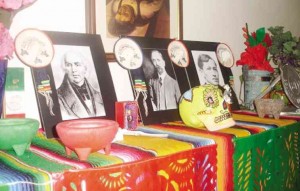
Dia de los Muertos, or the Day of the Dead, is one of Mexico’s most popular fiestas. The feast days coincides with our celebration of All Saints’ and All Souls’ Days.
In Mexico, the first day of November (Todos los Santos) is the day dedicated to muertos chiquitos or the departed children. The second of November (Fieles Difuntos), meanwhile, is when departed adults are remembered.
An e-mail sent by Señor Leopoldo Lopez, head of the Cultural Office of the Mexican Embassy in Manila, explains these celebrations: “The Día de los Muertos is celebrated throughout Mexico and is believed to be when the souls of the dearly departed return to their homes to stay with their living relatives and to partake in what is being offered to them at the altar. The altars could be quite elaborate, carefully prepared for them by their families.
Farming cycle
“The celebration of Todos los Santos and Fieles Difuntos was integrated into the commemoration of the Day of the Dead that the indigenous people of Mexico have been celebrating even during pre-Hispanic times. The ancient Mexicans incorporated their veneration of the dead in the Christian calendar that the Spanish brought to Mexico.
“However, before the arrival of the Spanish, the celebration was held during the month of August and coincided with the final cycle of the farming of corn, pumpkin, chickpeas and beans. The harvested products formed part of the offering for the dead.
“The Fieles Difunto has been an act of grief and prayer for the peace of the departed. And upon its integration with the indigenous tradition, its celebration was transformed into a fiesta, into a carnival of smell, taste and love where the living and the dead coexist…”
Apart from going to the cemeteries, Mexicans mark the Day of the Dead with material offerings for their departed loved ones. If the departed is an adult, then wine, liquor or hot punch is offered, to toast the life he or she lived.
Ofrendas or offerings “are placed in the altar decorated with papel picado or paper cut-outs, flowers, candles, calaveras de azúcar or sugar skulls and the photo of the departed, among others,” noted Señor Lopez in his e-mail.
Excellent cook
At the Mexican Embassy, I was introduced to a wonderful Mexican lady, Estela Lomeli Blanco, an excellent cook who said that different provinces and different families have their own way of commemorating the day.
The most popular offering is bread, particularly pan de muerto—“a symbol of the body of Christ and one of the most precious elements in the altar.”
There are over a hundred variations of the bread, usually made with eggs and orange zest, and sometimes with orange blossom water or anise. Blanco said once the dough has been formed according to the baker’s desired shape, he or she finishes the bread by decorating it with the same dough but, this time, the trimmings are shaped skillfully into bones. In some parts of Mexico, there are competitions held for the best rendition of pan de muerto.
The altar will also have calaveras de azúcar made by mixing sugar, egg whites, corn syrup and vanilla. The mixture is molded and colorfully decorated, with each sugar skull having the name of a departed family member written on the forehead.
“The small calaveras or skulls are dedicated to the Holy Trinity and to the great Eternal Father,” said Blanco.
Popular dishes
Water put on the altar is for the souls to drink after their long journey. Salt is also offered to cleanse, purify and keep the spirit away from harm, for it to return safely the following year.
Popular dishes also offered at this time year include mole; calabaza en tacha (pumpkin cooked in panocha or brown sugar syrup); and tamales. There are many more, with the selection varying from town to town and family to family. The food offered must be aromatic, to give delight to the visiting spirits.
“We offer and feast on the dead’s favorite food as our way of remembering them,” said Blanco. “It is also a time for reunions. In my family, we dance, tell stories and eat. We remember our dearly departed, happily—for, after all, the day is a celebration of life, for both the living and the dead.”
Pan de Muerto recipe from Estela Lomeli Blanco
- 5 c flour
- 5 tbsp yeast
- 4 tbsp warm water
- 5 egg yolks
- 5 eggs
- 2 bars butter
- 1 c sugar
- 3 tbsp agua de azahar orange blossom water (some recipes say anise)
- 1 tbsp orange zest
- 2 eggs for egg wash
- Pinch of salt
- Dissolve yeast in 4 tbsp warm water and ½ cup flour.
- Knead to make a ball.
- Let rest for 15 minutes, or until the dough doubles in size.
- Combine the flour, salt, sugar and make a well.
- On the center of the well, add the eggs, butter, zest, orange blossom water and the dough; let rest for 15 minutes.
- Slowly knead and incorporate the mixture into the flour. Continue to knead until the dough comes together.
- Form a ball and let the dough rest once again until double in size.
- Shape dough.
- Beat the 2 eggs and brush over the dough balls.
- Leave some dough to use and shape as bones to decorate it with.
Bake the bread in a preheated 350 oven for 30-40 minutes.
PHOTOS COURTESY OF MEXICAN EMBASSY MANILA AND GOVERNMENT OF MEXICO WEBSITE.

